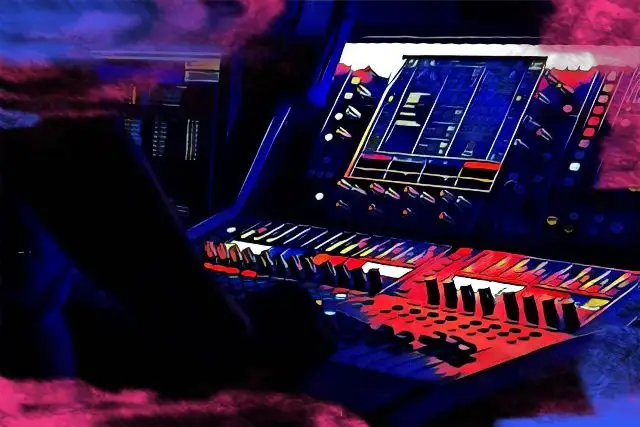In today's world of digital music-making, it's easy to forget that old staple found in the studio of yore: the analog mixer.
Mixers haven't gone anywhere; you still see them at live performances, and in studios. But often these are digital consoles.
I have nothing against a digital mixer. They're more versatile, often come with a large range of effects, and get the same job done.
Analog mixers tend to be simpler, 'what you see is what you get' affairs. And there's something undeniably satisfying about using one.
So for all you analog heads out there, here's our guide to the best analog mixers on the market today.
We'll be looking at a range of models with varying features. So whether you're into recording and mixing, or live sound, you'll find something to suit every budget.
And now, the juicy details...
The Best Analog Mixers For Live Sound
1. Soundcraft EPM8 High-Performance 8-channel Audio Mixer
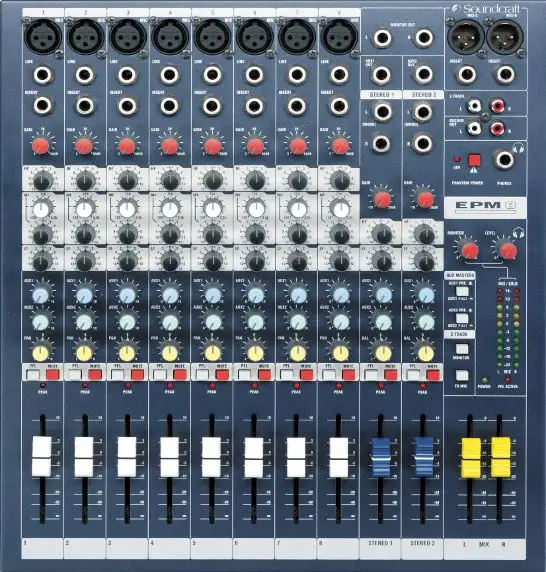
Quick Look
- 8-channel mixer, with two additional stereo inputs
- RCA stereo inputs and outputs
- 3-band EQ, with sweepable mid-range
- Two aux sends
- Comprehensive monitoring options
- Rack mountable
The Low Down
If you're just starting out in the audio engineering world, or you're looking for a compact, no-frills mixer to handle simple tasks, the Soundcraft EPM8 could be your new best friend.
The EPM8 is a pure analog mixer - not a microchip in sight. While this means you don't have any on-board effects, it is a great way to learn the ropes if you're a newbie to mixing live sound.
The 8 x XLR - 1/4" mono channels are perfect for a small combo set up. Each channel has independent phantom power, 3-band EQ, along with an insert, and two aux sends.
If you're using both aux sends for effects you'll need to make use of the two stereo inputs for the return signals. DJ-ing between live sets? No problem. The RCA stereo input will handle your Spotify playlist with ease.
And if you want to record your onstage shenanigans you can make use of the 2-channel RCA record output.
A ten-stage LED metering section gives a clear overview of your mix. Meanwhile the peak light on each channel gets gradually brighter as it nears its overload point.
A strange omission in the build is the lack of a power switch. Once you're plugged in, you're on, so if you plan to use it in for live sound, make sure your power-up sequence is in the right order.
In addition to live performances this mixer would be a useful addition for anyone needing something small to handle sub-mix duties, or for the lucky engineer who gets to mic up panelists at a conference.
Overall this is a solidly built mixer for live sound. The sound quality is great, especially for the price, and the durable build will last the rigors of the road.
Pros
- Sturdy and simple analog mixer
Cons
- No power switch - be careful with your power up sequencing!
2. Behringer Xenyx X2222USB
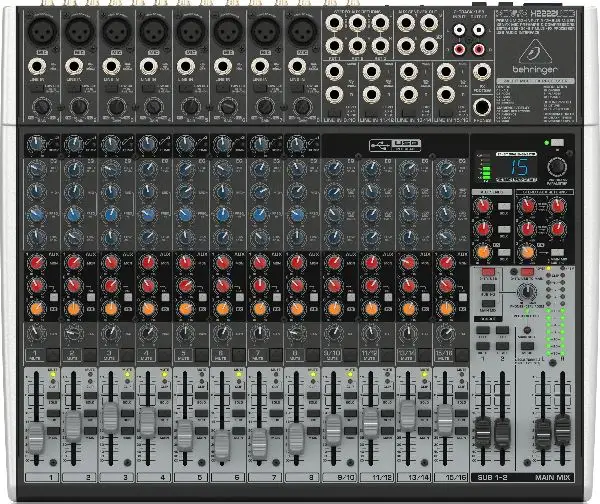
Quick Look
- 16 input channels (8 mono, 4 stereo)
- 24-bit multi-FX processor on board
- 3-band 'British' equalizer on each strip
- Onboard 'one knob' compressor for mono channels
- USB/Audio interface allows for recording directly into software
- 2 sub-groups with separate outputs
The Low Down
Another great mixer for live situations is the X2222 from our friends at Behringer. While the name (and marketing) claims there are 22 input channels, in practical terms there's 16 places where you can plug in a mic or an instrument.
Despite this, it's packed with features and this analog mixer is surprisingly affordable for the budget conscious engineer.
Each mono channel comes with it's own compressor knob - a one-stop sound-sculpting stop, with an LED indicator to show the compressor is active. Not as versatile as a compressor insert (although inserts are available on these strips), but hand for reigning in wayward transients.
All channels have three aux send options, one of which is dedicated to the built-in digital effects, and the option of routing to the main mix, or one of two sub-mixes.
The Xenyx mic preamps deliver a clean sound with plenty of dynamic range.
The mixer has a built-in audio interface allowing you to connect directly to your recording software and sends the main stereo mix over USB. Handy if you want to capture a clean recording of a gig, but not really functional in a studio situation.
The Xenyx is a versatile mixer with lots of practical applications, ideal for small to mid-size bands and events, and comes with a price tag that won't leave you sweating.
Pros
- Excellent value for money for small to medium live sound needs
Cons
- No gain control on stereo channels
3. Soundcraft Signature 16
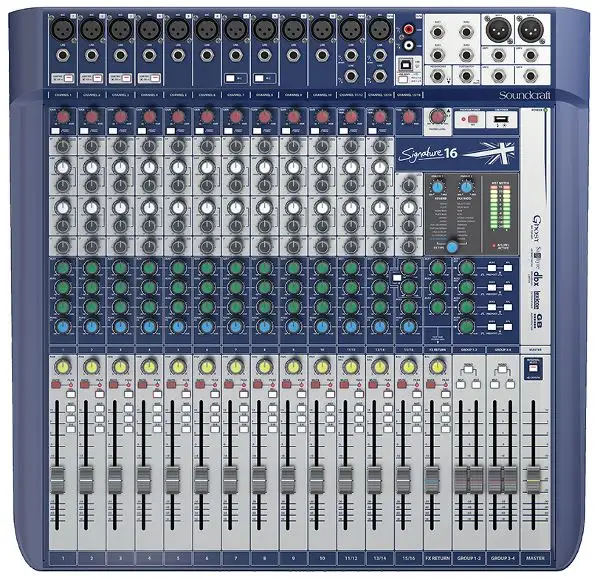
Quick Look
- 16 channel mixer (10 x mono, 3 x stereo)
- Built-in limiter on 4 inputs
- Switchable Hi-Z inputs (2)
- Hi-pass filters and phantom power on all mic channels
- 4 auxes
- 4 x mono/2 x stereo subgroups
- 4 band eq (2 sweepable mids)
The Low Down
The Soundcraft Signature 16 is one of a series of impressive range of high performance audio mixers with built in FX.
Each of the XLR-TRS inputs has access to phantom power, 4-band EQ, and a hi-pass filter. Two of them have switchable Hi-Z buttons, and another four have a limiter button for taming peaks.
The last two inputs are a stereo RCA pair, or for use with the digital 2-track USB connectivity. This is a nice feature if you're performing with (gasp) tracks to fill out your live sound.
The Ghost mic preamps are drawn from Soundcraft's top-of-the line professional mixing consoles, and offer low noise performance.
The EQ, with its two sweepable mid-ranges is equally as pleasing.
All the channels offer four aux routing options, one of which can be used for the onboard effects. These offer a range of standard reverb, delay, and modulation-type effects more than adequate for a standard gig, but perhaps not what you'd turn to if you were recording.
The XLR main output is complemented by (up to) four separate group outputs, and four outputs from the auxiliary sends.
One of the great features about the Signature 16 is the 100mm faders giving you even more precise control over your mix.
This mixing console, with all its features, is great for live performances, but it would also sit nicely in a home studio.
Pros
- Sturdy metal build is great for touring
Cons
- No inserts on any channels
4. Yamaha MG20XU
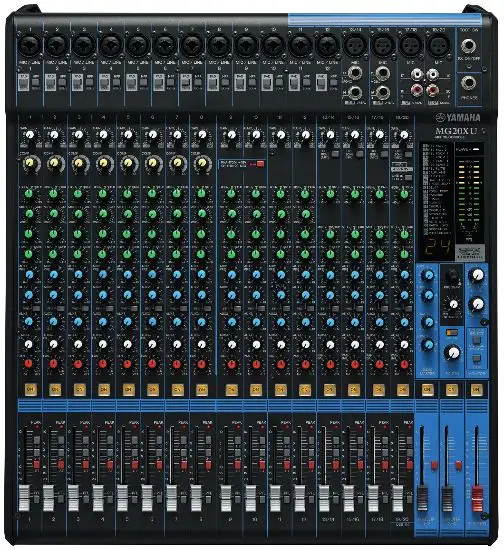
Quick Look
- 20 channel mixing console (16 x mono/4 x stereo)
- 4 group busses, 1 stereo bus
- 4 aux (including FX)
- 1 knob compressors
- SPX digital effect processors
- 3-band EQ and hi pass filters
The Low Down
Edging up into the four-figure mixer territory is the clean-sounding MG20XU from Yamaha.
While it's quite an initial outlay you get a lot for your money, and the mixer would work equally as well in a live or studio setting.
The impressive 20 inputs all have a 3 band equalizer and 4 aux sends on each strip.
The 20 channels are made up of 12 x XLR/TRS combo inputs, and 4 XLR or line inputs for the final 4 (stereo) channels. The final 2 of these are unbalanced RCA stereo pairs, and the last can receive digital audio via the USB interface.
All 20 channels can receive phantom power, and make use of the onboard effects processor.
The first 8 channels have a one-knob compressor feature for painless control of dynamics, and sweepable mids on the EQ.
All channels can be routed to one of the four group busses, each of which has an independent output. There's also a separate stereo monitor out, in addition to the XLR main outputs, and four aux outputs.
So, a lot of connectivity going on here. And if you're wondering how the sound quality is, you're in luck. It's a clean, pristine mixing machine, thanks in part to the inverted Darlington circuit mic preamps.
While the mixer is rack mountable, it features a raised top end (thanks to all the outputs being on the rear), so sits at a nice angle on your desk/plank of wood/barstool. It's a tad heavy to lug around, but metal chassis will withstand the most brutal touring conditions (or meanest conference panelists, if that's your thing).
The MG20XU is an investment, but one well worth making if you're in the world of mixing mid-size ensembles, and need the flexible routing options available here.
Pros
- Lots of inputs and output options
Cons
- Pricey for the beginner
The Best Analog Mixers For Home Studios
1. Presonus StudioLive AR16c
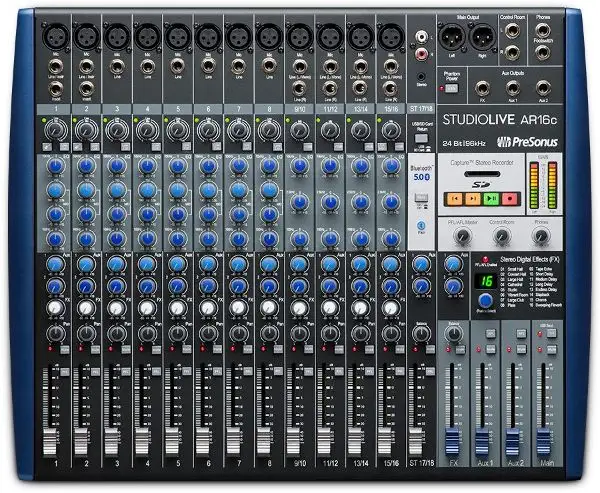
Quick Look
- 18 channel Analog mixer
- 2 x 1/4" switchable Hi-Z inputs
- 2 x aux sends, plus 1 x FX send per channel
- Onboard 2x2 SD recorder
- RCA/ 1/8" Bluetooth stereo inputs
- 24bit/96kHz USB audio interface - records every channel individually
- Onboard effects processor with 16 presets
The Low Down
With the Presonus Studiolive AR16c you're getting the best of both worlds; a quality sounding analog mixer, and a USB audio interface in one compact unit. And when you factor in the channel count it's a very reasonable price to boot.
While the AR16c is suitable for live sound work too, we're focusing here on why it would be a great addition to a project or home studio set up.
Firstly, unlike many desks that include USB features it does more than just capture the stereo output of the board.
Each of the 18 channels can also be recorded directly via USB, giving you a true multi track recording experience.
You can also capture the stereo output of the board on an SD card for snap recordings or live recording.
The XMAX mic preamps on the AR16C deliver the same pristine quality as their audio interfaces, and are featured on all 12 of the mic inputs. The last four mic-line inputs double up as stereo line inputs.
A further channel strip offers stereo connectivity via RCA, 1/8" stereo jack, or Bluetooth connection.
Each mono channel features a low pass filter button and has sweepable mid-rang on the parametric EQ.
For monitor feeds there's two auxiliary sends (although these are mono only). You could feasibly rig a third monitor feed via the control room output, and use the main L/R out for your control room feed.
The onboard effects, while rather basic, are adequate enough to add some sweetness to the feed for the purposes of recording, and you won't suffer from latency issues. Capturing the signal dry direct from the channel means you can play around with effects at the mixing stage.
To top it all off there's a nice bundled software package that ships with the mixer. You could realistically just buy this desk and have everything you need for music production in the studio, live sound, and podcasts. And conference panelists.
Overall the Presonus StudioLive is a great mixer for bands who do DIY recording, or the up-and-coming sound engineer who wants to cover all her bases when it comes to client fulfilment.
Pros
- True multi-track recording on an analog mixer for less than you'd expect
Cons
- USB cable is only 3ft, and non-switchable
2. Tascam Model 24
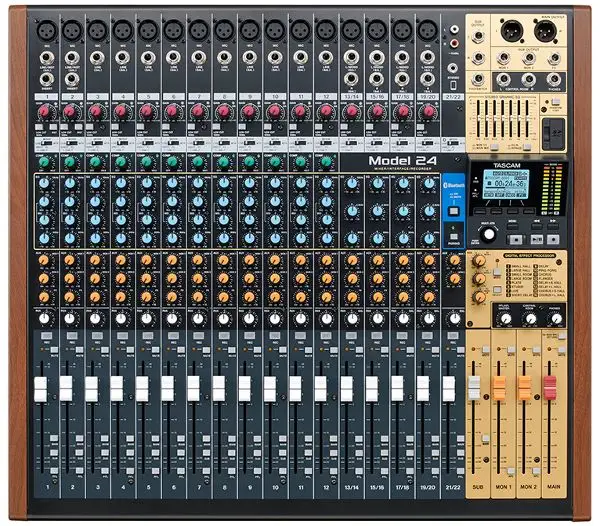
Quick Look
- 22 input channels
- 24 track 24bit/48kHz USB interface
- 7-band graphic EQ/3 band parametric EQ
- 12 channel compressors
- 2 aux/monitor sends
- 1 x subgroup
- 2 x Hi-Z inputs
- Bluetooth connectivity
The Low Down
The Model 24 from Tascam is similar to the Presonus Studiolive, with more channels, an onboard multitrack recorder, and (in my opinion) a nicer looking trim. Hey, what can I say - I'm shallow like that.
The 22 inputs include XLR and balanced line inputs, 2 switchable Hi-Z connections, one-knob compressors on every channel, a high pass filter, and 2 monitor sends, plus an FX send per channel. That's more than enough for a decent-size band to do a multi track recording into a DAW.
Note that the onboard digital FX don't get sent to our DAW via USB, but they will feed your monitor mixes with zero-latency. The 7-band graphic eq can be routed to the main output, and the monitor mixes. Especially useful if your drummer likes lots of sizzle in their mix.
The 100mm faders give you that little bit extra wiggle room for fine-tuning your mixes, and the TASCAM mic preamps will give you a clean sound with just the right amount of analog warmth.
One of the best features about the Model 24 is that once you've flown everything into the DAW, the USB connectivity will work the other way too. Send tracks out from your DAW and mix like they used to do with actual, real faders.
Obviously the Model 24 is more than just an analog mixer for the studio. With its wealth of features this bad boy will easily handle live work too, without the need for any additional outboard gear.
And if you want a recording of the live sound you can use the onboard SD card to capture the gig as a multi track recording too! This can be exported to a DAW for further editing and mixing.
The Tascam Model 24 is a fantastic choice as an all-singing, all-dancing analog mixer for bands, or engineers who work with varying ensemble sizes.
Pros
- Excellent sounding mixer for in the studio or on stage
Cons
- Digital display is tiny compared to size of console
3. Solid State Logic BiG SiX
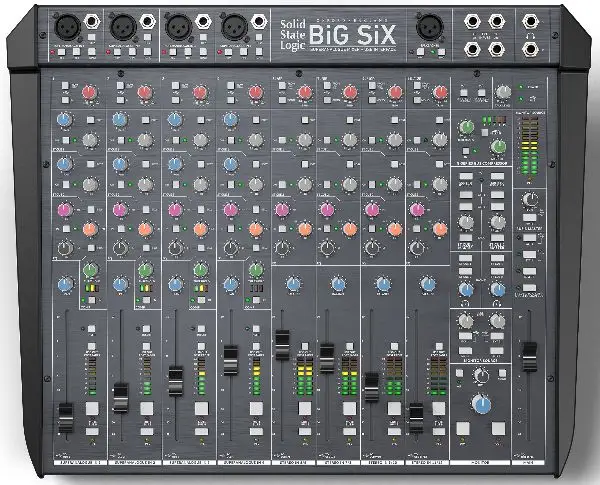
Quick Look
- 12 channel analog mixer (4 x mono/4 x stereo)
- Classic SSL processing on every channel
- 24 bit/96kHz USB-C Audio interface
- Talkback mic input
- Three band parametric EQ
The Low Down
Okay, we all know that Solid State Logic is another way of saying 'awesome analog sound quality'. And the BiG SiX from SSL offers a perfect hybrid solution for someone wanting an analog mixer built by giants of audio to integrate with their forays into digital recording.
The 4 x XLR inputs on the front panel double up as high impedance inputs. The mic preamps are 'SuperAnalogue'. Essentially an SSL creation, these preamps are exceptionally transparent and offer up to +72dB of gain.
The three band EQ on each strip is taken from the SSL E-series console. They're at set frequencies so it's gentle work only for these babies, although you can switch between bell and shelf curves on the high and low frequencies.
Around the back of the console is where all the routing magic happens, including strip inserts, 2 monitor feeds, and main bus inserts.
Finally, and perhaps justifying the cost of the mixer, a G series bus compressor is available over all of the main outputs on the BiG SiX. This magic compressor will add classic SSL punch and glue to your mixes.
This tasty mixer comes with a steep price tag. But if you're an SSL fan and want to have the best of both worlds while straddling analog and digital it's worth taking a look.
Pros
- Get the best of analog and digital mixing in one streamlined box
Cons
- No sweepable mids
4. Soundcraft Signature 22MTK
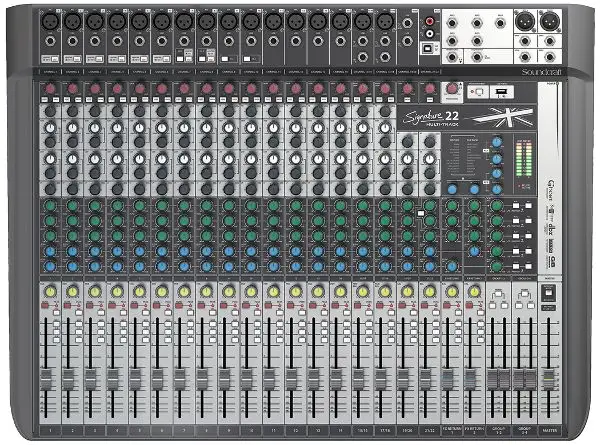
Quick Look
- 22 channel mixer with onboard FX
- 4-band parametric EQ and high pass filter on every strip
- 3 x aux busses, 2 x aux/fx busses
- Switchable Hi-Z inputs
- 24-in/22 out built in audio interface
- 100mm faders
The Low Down
The Signature 22MTK is the bigger brother of the Signature 16, with more channels and the ability to send individual track audio to your DAW via USB connectivity.
So if you're a band, or a composer who works with a lot of acoustic/outside the box instruments this is a great solution to set up in your home studio.
16 of the 22 inputs have the Soundcraft seminal Ghost mic preamps with +48v phantom power, offering a crystal clear, transparent sound to your recordings.
8 x XLR inputs can benefit from the dbx limiters, and all channels can tap into the array of Lexicon digital effects.
Sending multiple monitor feeds to performers is a breeze thanks to multiple auxes and flexible routing options.
One thing worth noting is that USB audio is sent pre fader so you can't fiddle with the signal before it enters your DAW. Once it comes back to the mixer you can apply all the onboard FX and EQ you want, and if necessary send the resulting mix back into your DAW or mastering program as a print.
It's also worth noting the faders are 100mm so you get fantastic control over your mixes.
The 22MTK is a great mixer solution for a home studio that doesn't want to be constantly plugging and unplugging instruments. There's enough channels to cope with almost any situation, and plenty of aux and group sends for monitor feeds.
You'll also have a great mixer for live situations too!
Pros
- 22 input/output audio interface and mixer in one unit
Cons
- No insert points
The Best Compact Analog Mixers
So far we've looked at multi-input audio mixers, best suited for bands and small ensembles, or home studios looking for versatility and functionality.
But even if you're a solo artist working with just a mic and a guitar you still might want the best analog mixer to suit your needs.
The following is our top pick of audio mixers with fewer channels, compact enough to lug around from gig to gig, but versatile enough to make your music sound like an expensive studio.
1. Mackie Mix 8
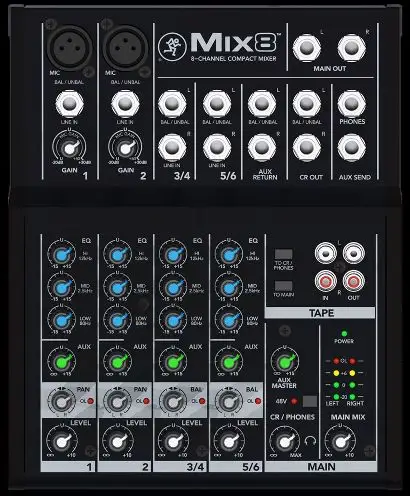
Quick Look
- 6 input mixer with phantom power
- Aux send/return
- 3 band equalizer
- RCA in/out for additional routing options
- Tough, durable build
The Low Down
The Mackie Mix 8 is a tiny little mixing powerhouse, suitable for solo artists, duos, or even DJs.
There's two mic/line inputs (with phantom power), and dual stereo inputs. A stereo aux return allows for use of external effects processing since there's none onboard.
There's a separate volume knob for the control room/phones output and the main feed, so in a live situation you could comfortably feed a stage monitor in addition to using the aux feed for effects.
A pair of RCA stereo in/outs allows for routing to a device for (admittedly basic) recording, or use of playback tracks. Note that there's no volume control over the RCA input.
While it's a basic mixer, the Mix 8 offers great sound quality and a sturdy build. It's ideal for small gigs or streaming basic performances.
Pros
- Compact and roadworthy
Cons
- No control over RCA input volume
2. Allen & Heath ZEDi-8
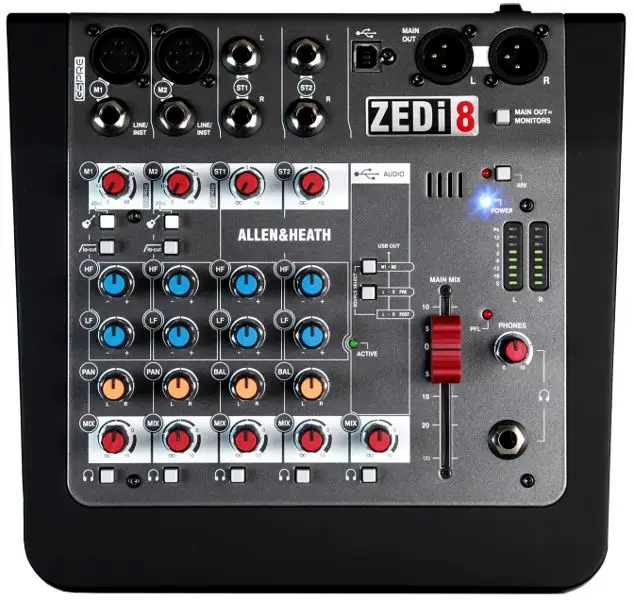
Quick Look
- 4 channel mixer (2 x mono, 2 x stereo)
- 2-in/2-out USB interface (24bit/96kHz)
- Switchable Hi Z inputs
- USB sends pre or post fader
The Low Down
Allen & Heath have been around since the swinging 60s and have built quite the reputation for high performance audio gear.
The uber-compact ZEDi-8 reflects all the best parts of Allen & Heath at a decent price, and is a great choice for a small ensemble performing live, or a compact home studio with no need for bajillions of features.
The two mono XLR/TRS inputs are Hi-Zs witchable, and feature a low cut button. Two further stereo inputs feature a trim knob.
The individual channels each have a basic 2 band equalizer, and a knob to adjust the overall level. They can be individually assigned to the headphone mix, but without any separate control over the level.
A smooth 60mm fader controls the main mix, which is sent out via 2 x XLR outputs.
The beauty of this analog mixer lies in its USB connectivity. The preamps offer transparent recording directly to your DAW, and it's possible to blend the incoming USB audio with the main mix to give you control over your monitoring situation.
So if you're a solo artist who gigs, and needs an audio interface I'd highly recommend the ZEDi-8.
Pros
- Great sounding, affordable audio interface/mixer combo
Cons
- Headphone output sums to mono
3. SSL Logic SiX
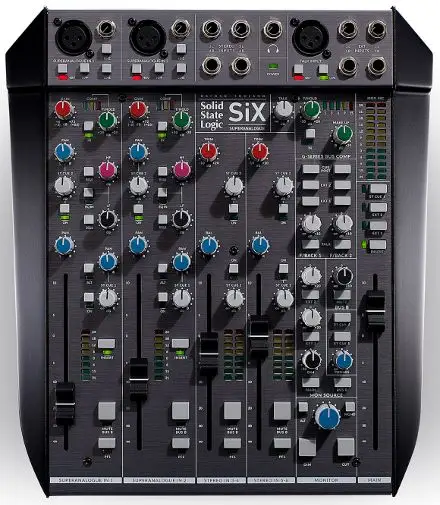
Quick Look
- 6 input analog mixer
- One knob SSL compressor circuit on mono channels
- G series mixbus compressor on main output
- 2 cue send
The Low Down
Slightly less affordable than the Allen & Heath ZEDi range is the SSL Logic range of compact mixers.
What it lacks in USB connectivity, it makes up for in professional quality compression options and sheer routing power.
Two mono inputs allow for individual phantom power and are powered by SuperAnalogue mic preamps. These offer +72dB of gain, and give a highly transparent sound.
Each of the mono strips accepts a line input, which can be switched to for guitars, basses etc. And each one features classic SSL processing in the form of a channel compressor circuit.
There's also two stereo inputs with trim and a talkback mic input.
On the downside, it's expensive, especially given the lack of USB connection and the number of inputs. But if you're a sound-a-holic and crave a large console sound without the real estate, the Logic SiX is for you.
Pros
- Large console sound in a bite-sized package
Cons
- No USB connection
4. Yamaha MG10X
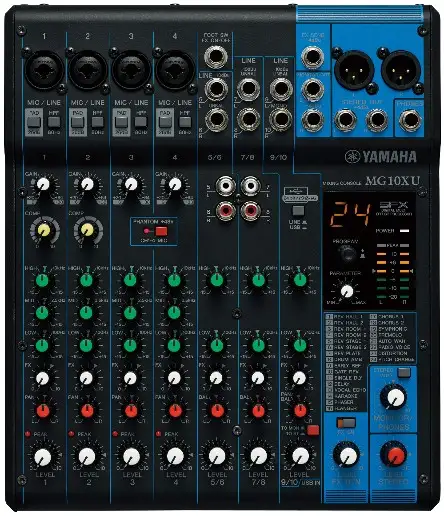
Quick Look
- 10 input mixer
- One knob compressor feature
- 24 digital effects
- 1 x bus out (monitor L/R)
The Low Down
Last on our list of audio mixers is the tidy MG10X from Yamaha.
It's a 10-input mixer, with 4 x XLR/line ins, and 3 pairs of stereo inputs. Two of the XLR feeds have one knob compression (for taming belty singers), and all four feature a high pass filter at 80Hz.
Two of the stereo channels can take RCA stereo inputs, and all channels can make use of the onboard digital effect processor.
Some of the effects are admittedly questionable (do I really want to know what the 'karaoke' preset would do to a voice?), but functional with the reverb/delay options.
There's no aux feeds or busses on this mixer, so you won't be able to create a separate monitor mix. There is however a monitor L/R out separate from the main mix so you can at least have a form of monitor mix.
While it's very no-frills, the MG10X is an affordable mixer for small ensembles performing live, or for mixing a multi-mic podcast on the fly.
Pros
- Compact and affordable analog mixer for small bands/multi-mic podcasts
Cons
- All rotary controls - no faders.
Conclusion
Our overall top pick for best analog mixer is the Tascam Model 24 .
It's an affordable price, packed with useful features, and is versatile enough to hold its own in the studio or on the road.
Everyone has different tastes and different needs though, so the best analog mixer for you might not be the right choice for Bob next door.
Do your research, figure out your needs, and stick to your budget.
Now go forth, and mixeth the music.


